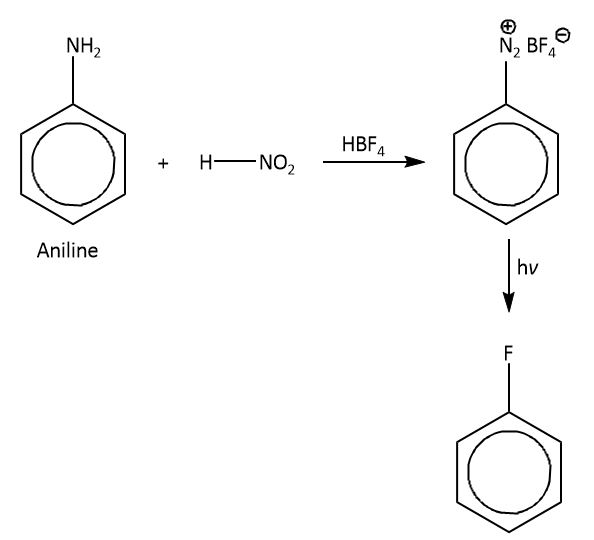
Fluorobenzene
(A) By heating phenol with
(B) From aniline by diazotization followed by heating the diazonium salt with
(C) By direct fluorination of benzene with
(D) By reacting bromobenzene with
Answer
492.9k+ views
Hint: As we know that the fluorine atom is very small in size and also is an electron rich atom and
Complete step by step answer:
If we use fluorine gas directly it can be very explosive due to its very small size and more electrons around the fluorine nucleus.
So in laboratory we synthesis
The mechanism is shown as below.

Therefore, the correct option is option (B).
Note:
Diazotization can also occur in the presence of other acids such as sulphuric acid, hydrochloric acid.
Complete step by step answer:
If we use fluorine gas directly it can be very explosive due to its very small size and more electrons around the fluorine nucleus.
So in laboratory we synthesis
The mechanism is shown as below.

Therefore, the correct option is option (B).
Note:
Diazotization can also occur in the presence of other acids such as sulphuric acid, hydrochloric acid.
Recently Updated Pages
Master Class 4 Maths: Engaging Questions & Answers for Success

Master Class 4 English: Engaging Questions & Answers for Success

Master Class 4 Science: Engaging Questions & Answers for Success

Class 4 Question and Answer - Your Ultimate Solutions Guide

Master Class 11 Economics: Engaging Questions & Answers for Success

Master Class 11 Business Studies: Engaging Questions & Answers for Success

Trending doubts
Give 10 examples of unisexual and bisexual flowers

Draw a labelled sketch of the human eye class 12 physics CBSE

Differentiate between homogeneous and heterogeneous class 12 chemistry CBSE

a Tabulate the differences in the characteristics of class 12 chemistry CBSE

Why is the cell called the structural and functional class 12 biology CBSE

Differentiate between insitu conservation and exsitu class 12 biology CBSE




